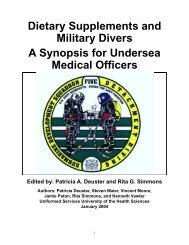Force Health Protection: Nutrition and Exercise Resource Manual
Force Health Protection: Nutrition and Exercise Resource Manual
Force Health Protection: Nutrition and Exercise Resource Manual
You also want an ePaper? Increase the reach of your titles
YUMPU automatically turns print PDFs into web optimized ePapers that Google loves.
Glossary<br />
acclimation -<br />
aerobic capacity -<br />
aerobic energy system -<br />
amenorrhea -<br />
anaerobic energy system -<br />
antioxidants -<br />
basal metabolic rate -<br />
body composition -<br />
body mass index (BMI) -<br />
Calorie -<br />
carbohydrates (CHO) -<br />
carbohydrate loadingcardiorespiratory<br />
fitness -<br />
cholesterol -<br />
dehydration -<br />
detraining -<br />
electrolytes -<br />
adaptations that occur within the body when exposed<br />
to a new environment.<br />
maximal amount of aerobic activity that can be done<br />
process of making energy (ATP) that requires oxygen.<br />
the cessation of menstruation not due to pregnancy or<br />
menopause; can be seen in women athletes whose<br />
nutritional intake is not adequate; one component of<br />
the female athlete triad.<br />
process of making energy (ATP) without using oxygen.<br />
compounds that prevent breakdown (oxidation) of<br />
substances in the body; nutrients such as Vitamin E<br />
<strong>and</strong> C have antioxidant properties.<br />
the amount of energy (kcals) required to maintain life<br />
when the body at rest (BMR).<br />
a description of the amount of body weight that is lean<br />
body mass (muscle, bones) <strong>and</strong> the amount of body<br />
weight that is fat.<br />
An index that looks at body weight in relation to<br />
height.<br />
a measure of energy used to describe the energy<br />
consumed in foods <strong>and</strong> expended through physical<br />
activity; Calorie with a capital “C” is the same as<br />
kilocalorie (kcal).<br />
a macronutrient that supplies 4 kcals per gram;<br />
primary nutrient found in the grain, vegetable, <strong>and</strong><br />
fruit food groups of the Food Guide Pyramid.<br />
nutritional training method used by endurance athletes<br />
to increase the amount of glycogen stores in their<br />
muscles before a competition.<br />
ability of the heart, lungs, <strong>and</strong> blood vessels to deliver<br />
oxygen-rich blood to <strong>and</strong> remove waste products from<br />
the exercising muscles; the more trained the person,<br />
the higher the cardiorespiratory capacity; see aerobic<br />
capacity.<br />
a substance made by the body that serves as a base for<br />
hormones such as estrogen <strong>and</strong> testosterone, is a part<br />
of all cells, <strong>and</strong> is consumed in the diet by eating<br />
animal products.<br />
a depletion of bodily fluids that occurs when not<br />
enough fluids are drunk to replace those lost through<br />
breathing, urination, <strong>and</strong> sweating.<br />
a loss of training adaptations that occurs when<br />
training stops; can be avoided, stopped or reversed<br />
through physical training.<br />
minerals in the body that help regulate fluid balance,<br />
are part of nerve conduction, <strong>and</strong> other essential bodily<br />
functions; examples include sodium, potassium, <strong>and</strong><br />
chloride.<br />
<strong>Nutrition</strong> <strong>and</strong> <strong>Exercise</strong> <strong>Resource</strong> <strong>Manual</strong> 143




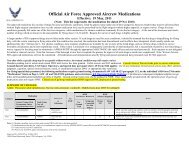

![Body Composition and Military [PDF] - Human Performance ...](https://img.yumpu.com/43269347/1/190x245/body-composition-and-military-pdf-human-performance-.jpg?quality=85)
![Tips for Grocery Shopping [PDF]](https://img.yumpu.com/37447379/1/190x245/tips-for-grocery-shopping-pdf.jpg?quality=85)
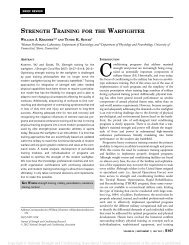
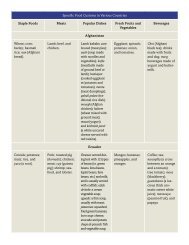
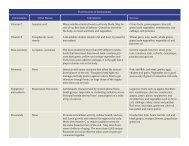
![Synthetic Drugs [PDF] - Human Performance Resource Center](https://img.yumpu.com/37447322/1/190x245/synthetic-drugs-pdf-human-performance-resource-center.jpg?quality=85)
